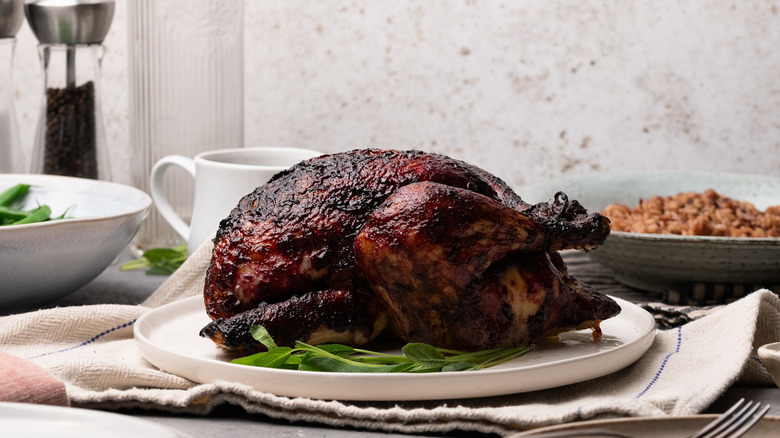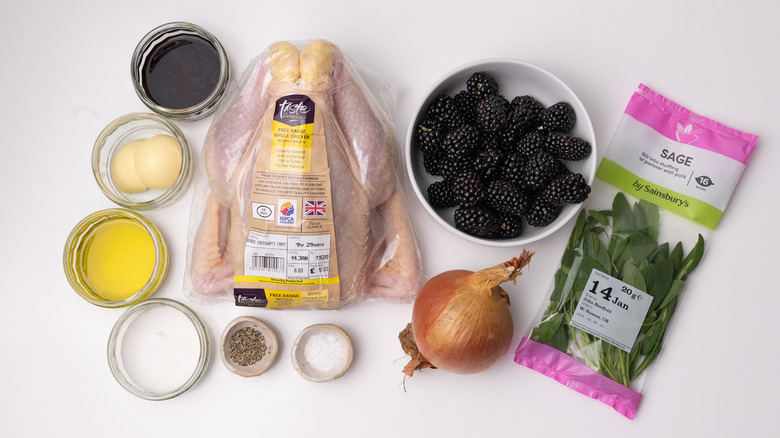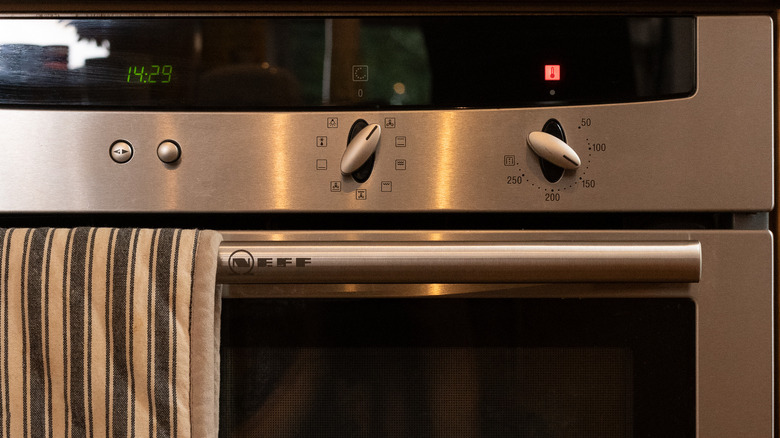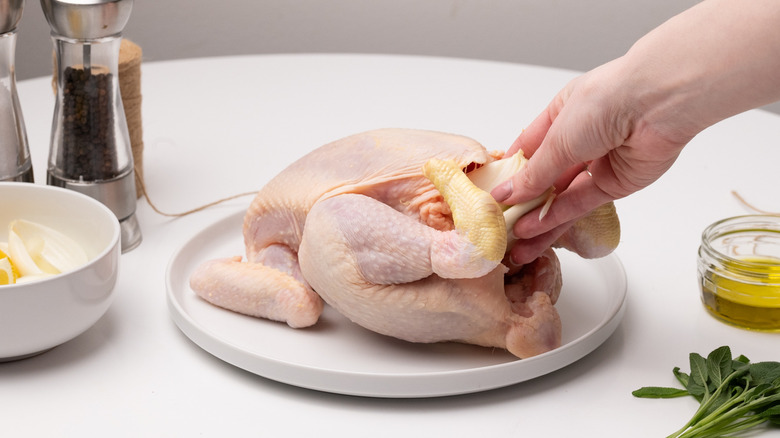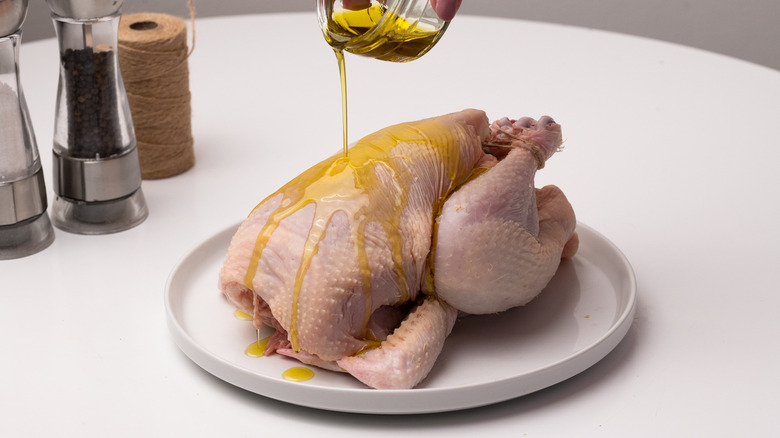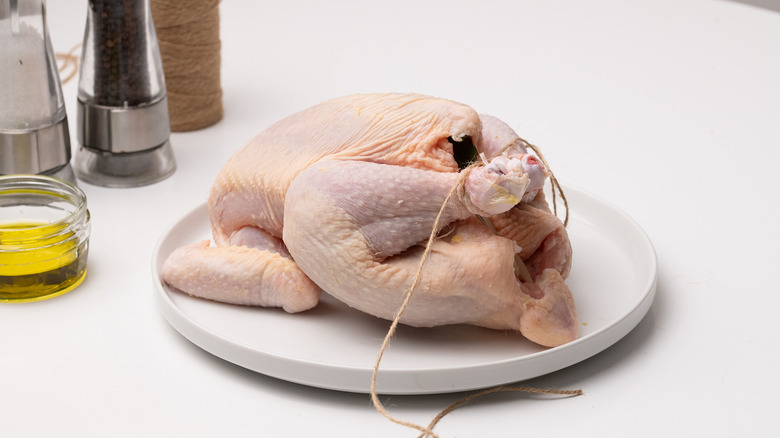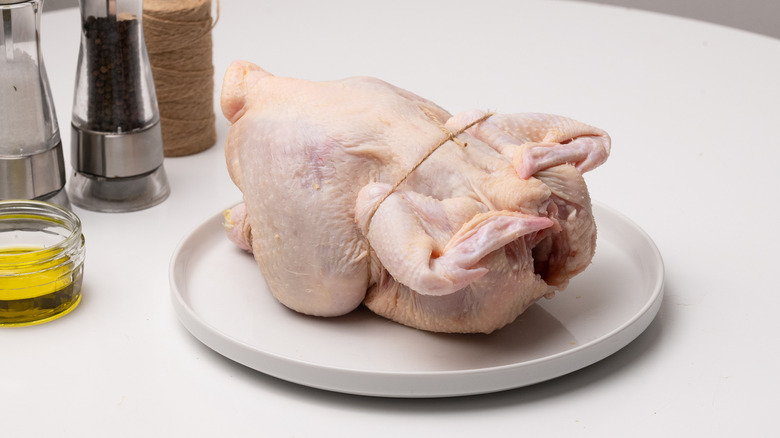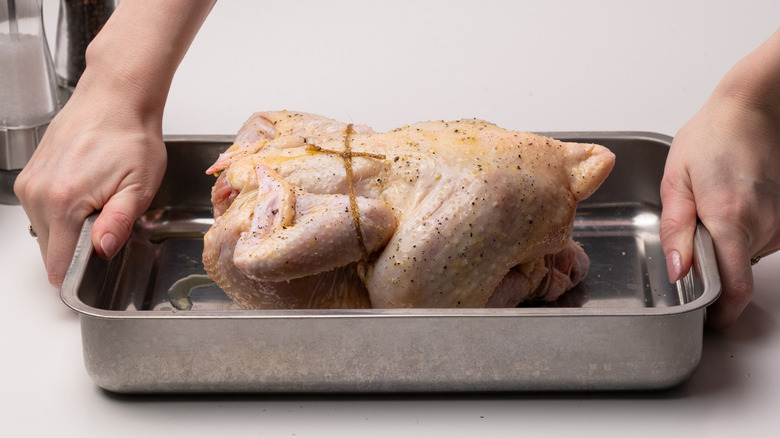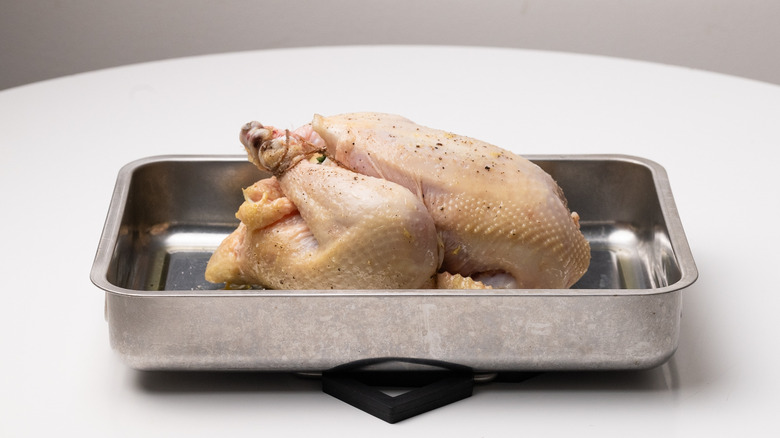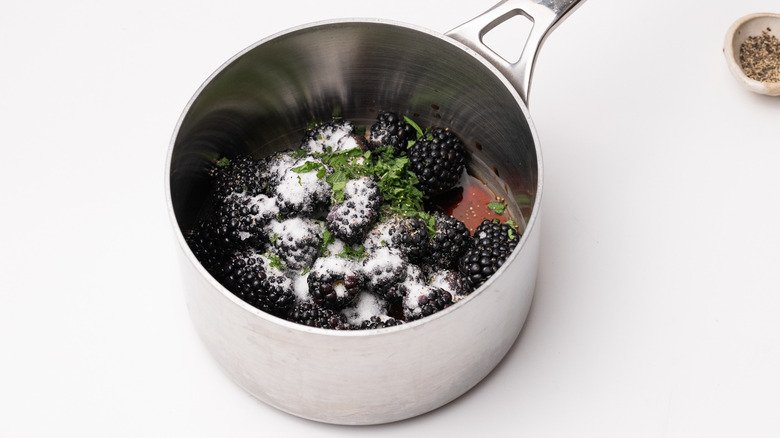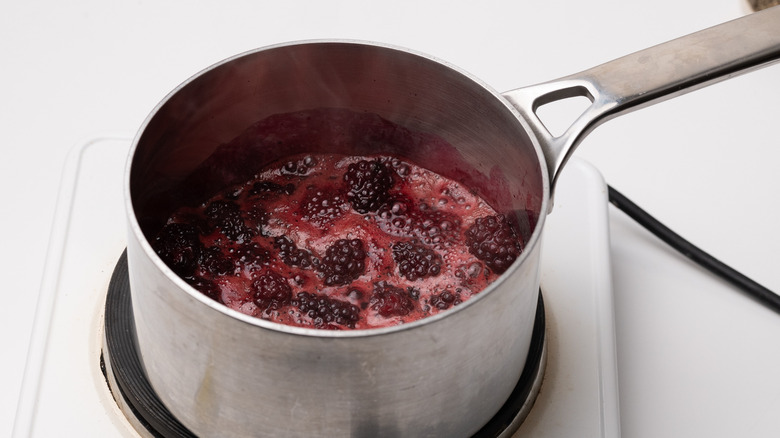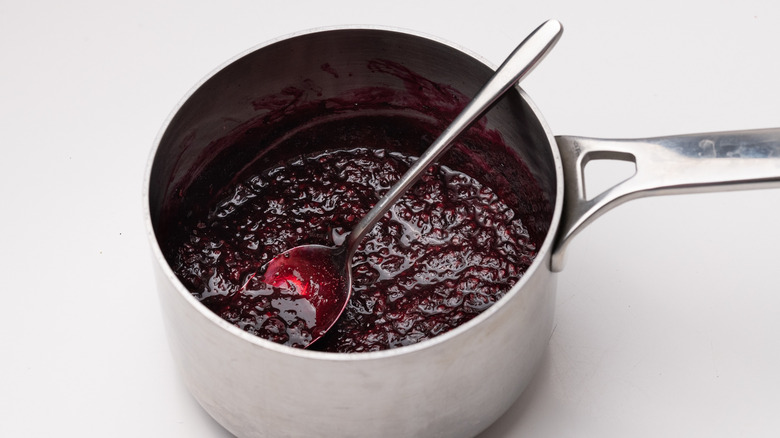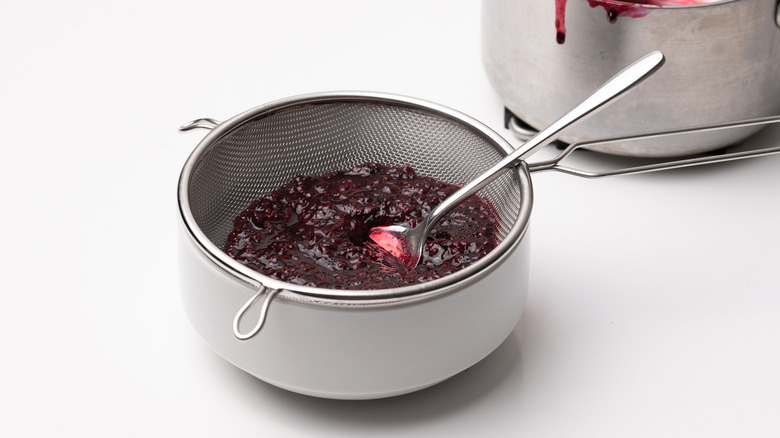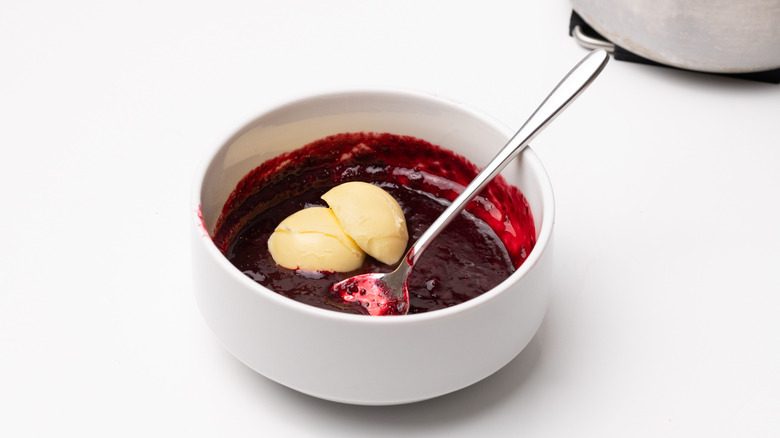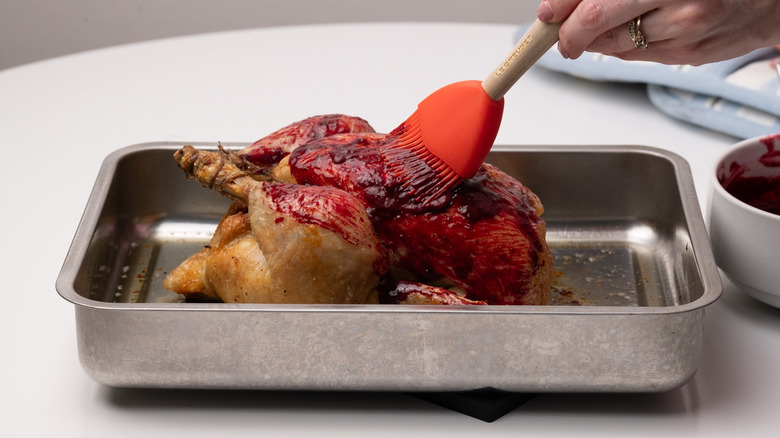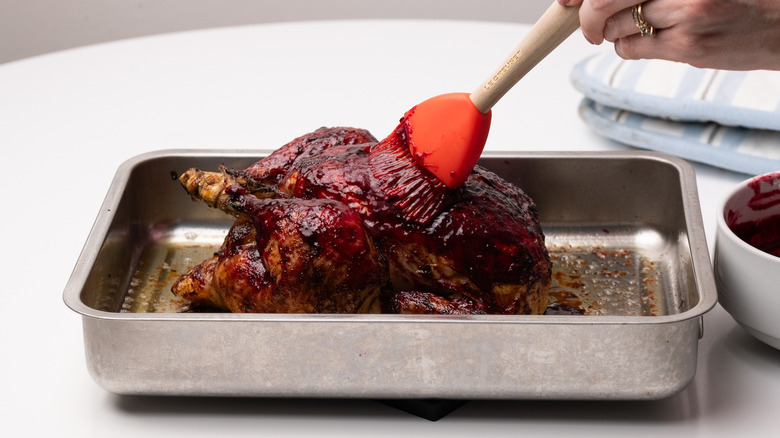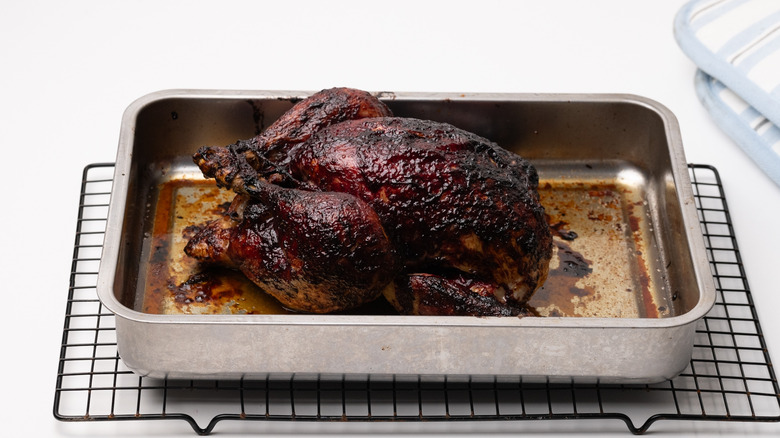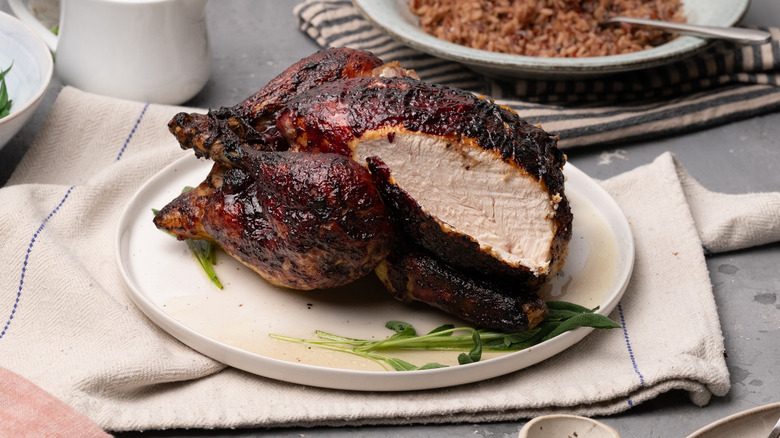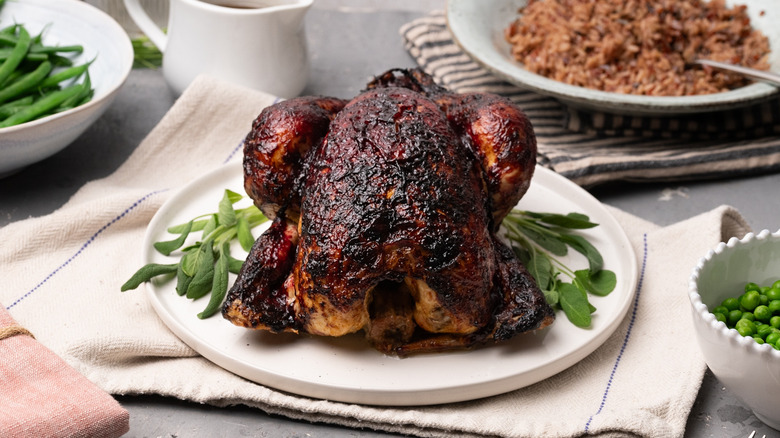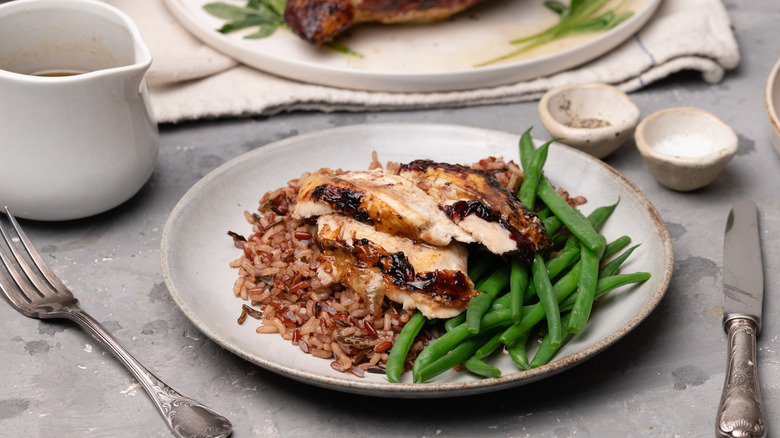Blackberry-Glazed Sage Roast Chicken Recipe
Elegant yet easy to make, roasted chicken is a well-loved and versatile dish enjoyed around the world. Roasting a chicken in the oven is perhaps the perfect way to cook this popular protein; the cooking process adds a whole lot of flavor and juiciness to the resulting meat, as the skin and bones contribute to the tenderness and the taste of the roast chicken.
This roast chicken recipe, from the kitchen of Tasting Table recipe developer Jennine Rye, combines the simplicity and succulence of a classic roast chicken with a well-balanced blackberry and sage glaze. The glaze provides a sweet and tart flavor profile with an earthy herbal undertone — while this flavor combination may seem a little unusual, the blackberry, sage, and chicken actually pair together beautifully, and the resulting chicken is gloriously juicy with a tart, fruity finish. This dish is perfect for upping your roast chicken game, or for those who want to embrace and celebrate the flavors of fall year-round. Read on to find out just how simple this decadent blackberry-glazed sage roast chicken recipe is to make at home.
Gather the ingredients for this blackberry-glazed sage roast chicken recipe
To begin this blackberry-glazed sage roast chicken recipe, first you will need to gather the ingredients. You will want a whole chicken, olive oil, half an onion, fresh sage, fresh or frozen blackberries, granulated sugar, balsamic vinegar, cold butter, and salt and pepper. Optionally, you can include a lemon to stuff into the chicken along with the onion.
Step 1: Preheat the oven
Preheat the oven to 375 F.
Step 2: Stuff the chicken
Stuff the chicken cavity with the onion, optional lemon slices, and sage leaves — reserve 3 or 4 leaves for the sauce.
Step 3: Oil and season the chicken
Rub the chicken all over with olive oil and season well salt and pepper.
Step 4: Tie up the chicken legs
Tie the chicken legs together using kitchen twine.
Step 5: Secure the wings
Turn the bird over and fasten the twine under the chicken to hold the wings in place.
Step 6: Start roasting the chicken
Transfer the chicken to an oven tray, placed upside down. Bake for 10 minutes.
Step 7: Rotate the chicken
Remove from the oven and turn the chicken right side up, then return it to the oven to roast for 1 hour.
Step 8: Begin the blackberry glaze
Add the blackberries, reserved sage, sugar, balsamic vinegar, ⅓ cup water, and salt and pepper to a small pan.
Step 9: Cook the blackberries
Heat the pan to a medium temperature and allow the mixture to simmer for 15-20 minutes, mixing and mashing the blackberries.
Step 10: Remove the glaze from the heat
Once the mixture has reduced and thickened, remove from heat.
Step 11: Strain the glaze
Strain the blackberry mixture through a fine mesh sieve to remove the blackberry seeds and sage.
Step 12: Stir in the butter
Stir in the cold butter and set aside.
Step 13: Brush the chicken with glaze
After 1 hour, remove the chicken from the oven and brush it all over with the blackberry glaze, then return to the oven for 10 minutes.
Step 14: Apply a second glaze
Remove the chicken once more and coat the chicken thoroughly in a second layer of glaze, before returning to the oven for a final 10 minutes.
Step 15: Rest the chicken
Remove the finished chicken from the oven, and allow it to rest for 15 minutes, reserving any juices for gravy.
Step 16: Serve
Carve with a sharp knife and serve.
How can you adapt this roast chicken recipe?
There are several ways this blackberry-glazed sage roast chicken recipe can be adapted, according to your personal preferences and what you can find in the store. To add more flavor to the roast chicken, why not stuff the chicken with some different herbs or garlic? The sage in this recipe can easily be substituted for other herbs. We recommend rosemary or thyme, as both pair wonderfully with blackberries and chicken. You could also try mixing different fruits into the glaze for different flavorful results: Peaches and plums are both great options. And, to switch up the glaze even more, you can try adding different spices, such as cloves or star anise, to give the roast chicken a spiced fruity finish.
For an even more flavorful finish, you can also consider brining the chicken, which will add extra taste and juiciness to the cooked bird. And, if you don't think you'll make it through an entire roast chicken, this recipe can easily be adapted for smaller chicken pieces, such as chicken thighs, drumsticks, and breasts. Just make sure to go for skin-on chicken for the best results, and adjust your cooking times accordingly.
What should you serve with this blackberry-glazed roast chicken?
This blackberry-glazed sage roast chicken is wonderfully versatile and can be served up in a variety of different ways. It pairs wonderfully when carved and served alongside a classic roast dinner consisting of mixed herb-roasted vegetables, freshly steamed greens and carrots, and a drizzle of homemade chicken gravy. It also pairs well with new potatoes, potato dauphinois, or mashed sweet potatoes. Other grains that can be served alongside this chicken dish are rice, couscous, and quinoa, and these can be served either hot or cold as a side salad to the chicken. A lemony roasted veggie quinoa makes a healthy and attractive accompaniment on your plate, alongside some mixed green leaves.
For other serving ideas, this roast chicken can be carved up and served cold on it's own. You could enjoy it shredded as part of a salad along with lettuce, nuts, and other fresh veggies, or as a delicious sandwich or wrap filling paired simply with some fresh leaves and mayonnaise.
Blackberry-Glazed Sage Roast Chicken Recipe
Switch up your roast chicken routine with this blackberry-glazed version, which provides the perfect sweet-tart-savory flavor profile.
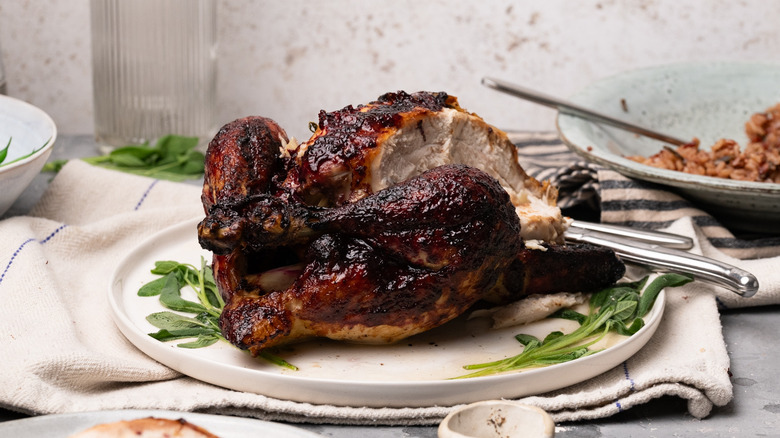
Ingredients
- 1 whole medium-sized chicken
- ½ onion, sliced into quarters
- 1 small bunch sage leaves, divided
- 2 tablespoons olive oil
- salt, to taste
- pepper, to taste
- 2 cups blackberries, fresh or frozen
- 2 tablespoons granulated sugar
- 2 tablespoons balsamic vinegar
- 2 tablespoons cold butter
Optional Ingredients
- lemon slices
Directions
- Preheat the oven to 375 F.
- Stuff the chicken cavity with the onion, optional lemon slices, and sage leaves — reserve 3 or 4 leaves for the sauce.
- Rub the chicken all over with olive oil and season well salt and pepper.
- Tie the chicken legs together using kitchen twine.
- Turn the bird over and fasten the twine under the chicken to hold the wings in place.
- Transfer the chicken to an oven tray, placed upside down. Bake for 10 minutes.
- Remove from the oven and turn the chicken right side up, then return it to the oven to roast for 1 hour.
- Add the blackberries, reserved sage, sugar, balsamic vinegar, ⅓ cup water, and salt and pepper to a small pan.
- Heat the pan to a medium temperature and allow the mixture to simmer for 15-20 minutes, mixing and mashing the blackberries.
- Once the mixture has reduced and thickened, remove from heat.
- Strain the blackberry mixture through a fine mesh sieve to remove the blackberry seeds and sage.
- Stir in the cold butter and set aside.
- After 1 hour, remove the chicken from the oven and brush it all over with the blackberry glaze, then return to the oven for 10 minutes.
- Remove the chicken once more and coat the chicken thoroughly in a second layer of glaze, before returning to the oven for a final 10 minutes.
- Remove the finished chicken from the oven, and allow it to rest for 15 minutes, reserving any juices for gravy.
- Carve with a sharp knife and serve.
Nutrition
| Calories per Serving | 828 |
| Total Fat | 58.2 g |
| Saturated Fat | 17.5 g |
| Trans Fat | 0.3 g |
| Cholesterol | 240.3 mg |
| Total Carbohydrates | 16.9 g |
| Dietary Fiber | 4.5 g |
| Total Sugars | 11.6 g |
| Sodium | 970.2 mg |
| Protein | 57.2 g |
